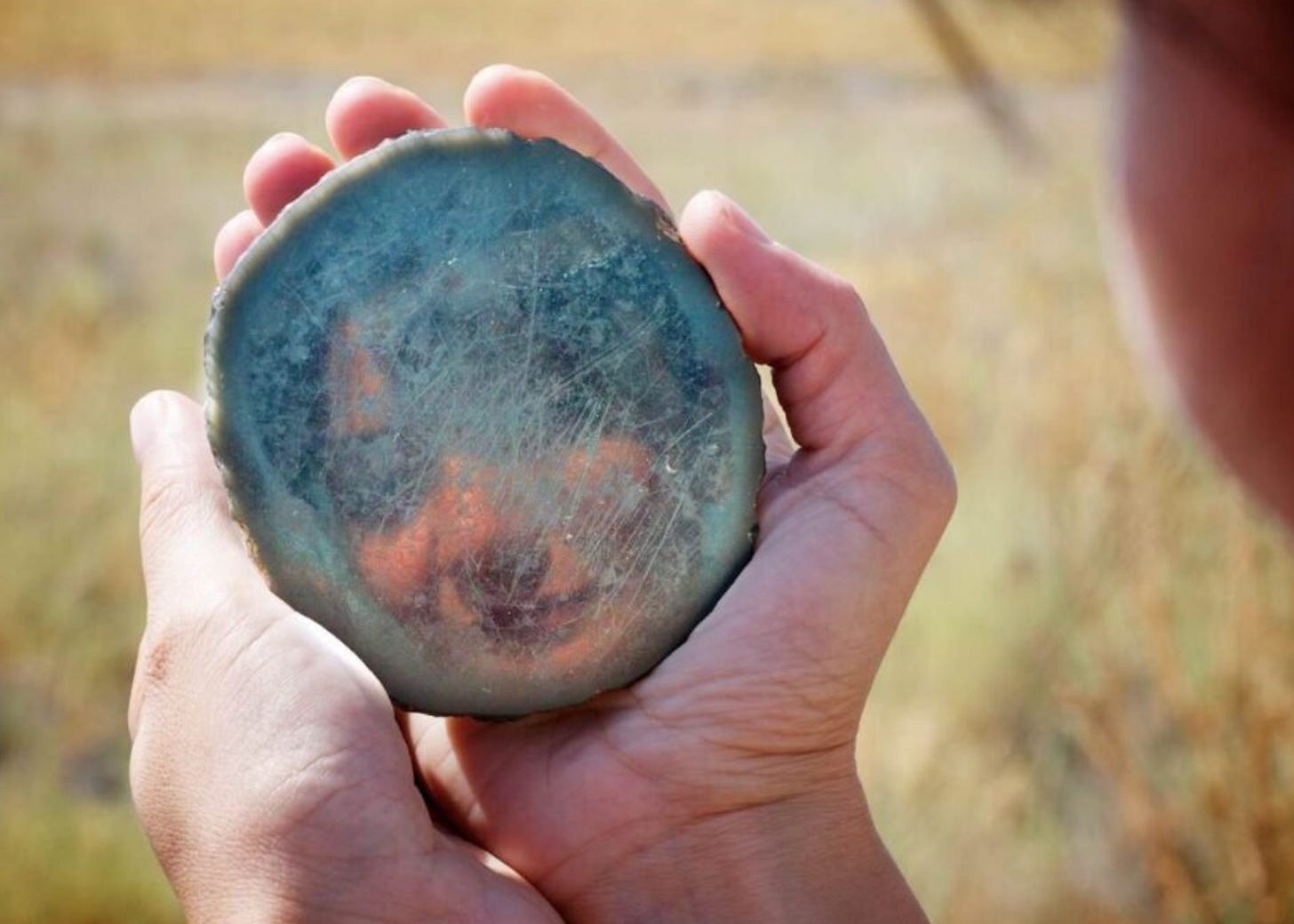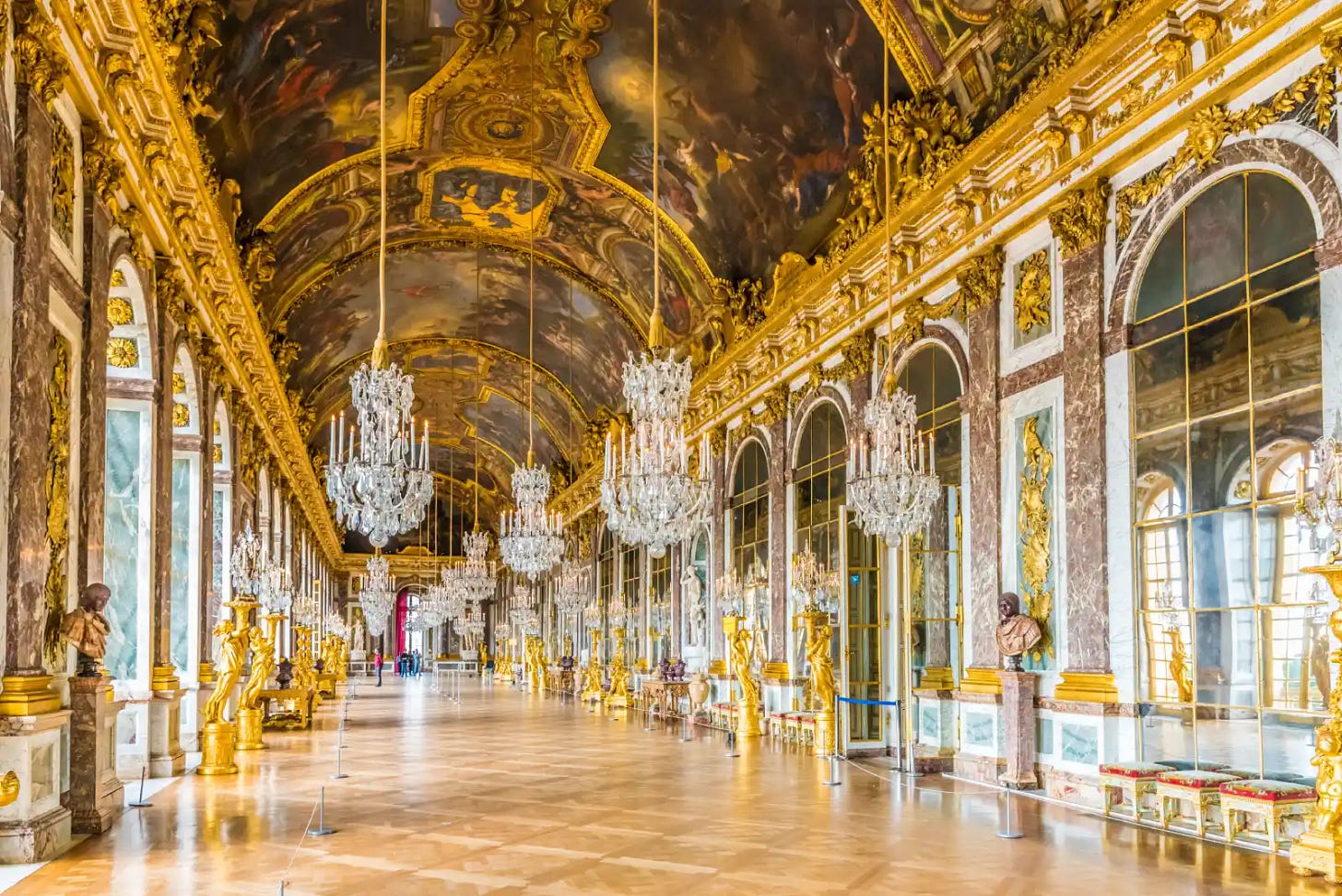I look in the mirror 57 times a day, does that mean I'm vain?
Our relationship to our reflection can be 'revealing' on so many levels...
Thanks for reading The Powder Room; a safe space to discuss beauty, body culture and identity and more. I write for a living, so please upgrade to a paid subscription - it really means a lot.
Last week I had an uncomfortable realisation; I’ve got a toxic relationship with the mirror. I was meeting friends for dinner and arrived at the restaurant. They were there already there so stood up to greet me, but instead of reciprocating I batted their approaches away with a ‘I really need the loo I’ll be back asap!!’ before making a beeline for the nearest bathroom.
Frens, I did not need the loo. I didn’t even try to have a little tinkle when I found the facilities. I went to the bathroom with the sole purpose of seeing how I looked. This wasn’t for any particular reason; I hadn’t knowingly smeared my lipstick or anything like that, it was entirely because I hadn’t looked at my reflection since I’d left the house an hour ago, and evidently, I needed to see myself before life could continue. Afterwards I returned to the group, relaxed and present.
On a recent date (no joy sadly, curb your excitement) I caught myself repeating the same worrying pattern. I entered the bar, greeted him speedily, said I needed the loo and went to check my face. When I returned I was instantly more confident and engaged. Over the next week I realised that this behaviour has become a pattern; one laced with appearance anxiety.
It's not like I’m not looking for anything in particular. But somehow I’ve slipped into a pattern where how I feel about my image has become a decider for how I show up in social situations. If I look unbecoming in some way, I feel more withdrawn, quieter and less confident. If I think I look ok, I’m calmer, chattier and infinitely more engaged.
I am glad I caught myself doing this, because it’s made me consider how destabilising this checking has actually become. What I’m looking for in the mirror is how others see me, and I don’t feel like I can be confident in myself, or present unless I know I look ok to the outward gaze. Even as I write this, it’s just clicked that the reason I never take the stairs from my flat down to the lobby isn’t because I’m lazy, it’s so I can check out how I look in the elevator mirror one final time before stepping into the outside world, with all it’s judgements.
Honestly, I don’t know if this is extreme, normal or somewhere in the chasm between. Either way it highlights a reliance on my appearance to give me confidence in a way I thought I’d overcome. Mirrors have such a pivotal place in our lives, yet we so rarely consider their impact and our relationship to them until it becomes extreme, and even then, we might not notice it; I genuinely have no idea how long I’ve been doing this.
Statistically it’s said that women check themselves in mirrors 38 times a day in order to seek reassurance, with Gen Z looking at themselves the most and Gen X the least. The latter actively avoids looking in mirrors in fact. That’s because they know that mirrors aren’t neutral and they can turn on us. The brightly-lit ones in shop changing rooms can ruin our self-esteem in a glance, but one look in a ‘skinny mirror’ does the opposite, it seems to boost our confidence. They can be both friend and foe, sometimes we trust them, and sometimes we don’t. They can make or break our day, all depending on what they reflect back to us, and how we perceive it. And they’re everywhere; sure they’re helpful to brush our teeth or do our make-up on the go, but so many other things now can as mirrors too, from car windows to phone cameras…and other peoples sunglasses (guilty).
It made me consider what life was like before mirrors. Is my dependance on them intrinsic, or is it a modern maladie that I - and many others - perhaps need to course-correct? The oldest known hand-created mirror dates back to 6000 BC, and was found in a Neolithic site in modern Turkey, whilst the ancient Egyptians were among the first to create rudimentary mirrors around 3000 BCE, using polished copper or bronze. These mirrors were small, handheld discs that provided a dim but functional reflection. The Greeks and Romans later refined mirror craftsmanship by using polished silver and gold and later glass.
The word 'mirror' comes from the Latin mirare meaning “to wonder at" and this fascination with our reflection connects the physical mirror with the concept of vanity or dwelling too long on one’s own appearance. But that depends on our motivation to obsessively mirror-check; for some it comes from anxiety about appearance and they seek verification of how they present to the world, for others using a mirror could reinforce critical self-judgements about our own appearance. Mirror checking could also be a verification of beauty for some; the word 'narcissism' describing excessive self-absorption or conceit, stems from a Greek myth in which the handsome youth, Narcissus, falls in love with his own reflection in a pool of water. In Disney’s Snow White the Evil Queen uses the Magic Mirror (above) to tell her she’s the fairest in the land, but one day the mirror turns on her and tells her that it’s actually Snow White who is the smokeshow. The Evil Queen predictably loses her sh*t.
Mirrors feature prominently in folklore and superstitions because we’ve always known how powerful our reflection is. One Chinese myth suggested that our mirror image was actually a demonic being who was silently plotting our demise. In Europe from around the 17th century, there was a belief that saying “bloody mary” three times in front of a darkened mirror would conjure a witch who - if you failed to pass her tests - would end you then and there. There was also a belief that mirrors revealed a person's true soul; a distorted reflection meant a corrupted soul, and those without souls – such as vampires – did not have reflections at all. And as I learned in Salem, Massachusetts a couple of weeks ago, some esoteric practices use catoptromancy, or the psychic art of divination through mirrors.
Not everyone had access to mirrors throughout history as these were truly luxury items when you were trying to survive or feed families. That’s why they eventually grew to become symbols of wealth and status because only the wealthy really had them. Craftsmen in Venice gained fame for producing high-quality mirrors using a combination of glass and a thin layer of metal, typically tin and mercury, and the rich decorated their homes with them. To keep up with this new fashion, mirrors began to find their way into the homes of the upper class, becoming prized possessions; the masterpiece of Louis XIV's Palace of Versailles was the 'Hall of Mirrors' contained a colossal 327 mirrors. But it wasn’t until the 17th century that flat glass mirrors began to be mass-produced in Europe.
The Renaissance (15th and 16th centuries) marked a period where mirrors started to shape cultural ideals of beauty. Painters would often use mirrors both within the portraits, and as a device for capturing a true likeness of their subject, with more life-like detail. These portraits would often set standards for physical attractiveness and people began to compare themselves to these artistic depictions and scrutinise their appearance. Mirrors remained expensive, luxury items until the invention of silvered glass in the 1830s by the German chemist Justus von Liebig, which meant they could be mass-manufactured. As such, mirrors became commonplace in households, so people had more opportunities for self-reflection. The middle classes were particularly fond of mirrors because this enabled them to mimic the upper classes in appearance and in having mirrors in the home.
In the 20th century the introduction of aluminum coatings and the development of shatter-resistant glass increased the durability and safety of mirrors. They started to become integral components of interior design, reflecting how much we value the importance of appearance. However it was the ever-present fine line; women were condemned as vain for looking in mirrors, but looking well presented was just as important. In Christianity vanity and pride were deadly sins and a result of self obsession, but in a patriarchal society, as Katy Kellehar says: "A woman at the mirror is practicing. She's seeing herself how men see her, how society sees her. She's assessing her value in figuring out how to enhance her worth, her power." Truthfully, part of me wonders if this is what I was doing - and how I’d even begin to recognise it if so.
By the 1950s, the beauty industry had created powder compacts and lipsticks with mirrors inside them so women could check their faces on the go, and had become a right of passage for teen girls by the age of 16, as female beauty became a bigger commodity and an industry. Now, mirrors have now evolved to magnify and zoom into our skin, to obsess over individual pores and imperfections. Interactive smart mirrors are equipped with touchscreens and embedded cameras in homes, fitness centres, and retail spaces. They’ve become an unnoticed daily presence in our lives, and something we trust implicitly.
But here’s the kicker - mirrors aren’t actually an accurate representation, but rather an image in reverse. Studies have shown that this is why people prefer how they look in a mirror to how they appear in a photo. When our friends tell us ‘we look great’ in said photo, it’s probably because they’re good pals, but also because this is how they are used to seeing us. The rise of smartphones and social media has also transformed self-perception - it’s a new way to look in the mirror, but now with the ability to change what we see, with filters and editing apps. If we don’t like what we see in the image, it's a mere swipe to change it, and to present an idealised version of ourselves.
If mirrors had stayed the rudimentary pieces of metal they were in antiquity, would we have become so obsessed with appearance in society? Either way the culture of checking our reflections has had an impact; in the study: "The Role of the Mirror: A Study of Women's Perceptions of Their Physical Appearance” researchers found that frequent mirror checking was associated with higher levels of body dissatisfaction and lower self-esteem, highlighting the potential negative impact of mirror use on mental health. Those with Body Dysmorphic Disorder often check mirrors excessively as can some people with OCD.
Mirror checking isn’t an easy habit to change; I’ve started to try and push past the uncomfortable urge to check how I look before I meet people. After all, somebody would surely tell me if there’s a misplaced bee tangled in my hair, or my eyeliner is smudged. Digging into why I might be doing this has been harder still because as our technology and culture around appearance continues to become more digitally led and inwards looking, so too could our relationship with our self reflection. Who knows, in a few years time, my mirror obsession might be totally normal - and that’s a truly terrifying thought.
Three ways to reclaim your reflection
Use the mirror to examine how you speak to yourself
Early research shows that being kind to yourself when you look in the mirror can reduce anxiety. To catch how your inner critic is showing up as you look at your reflection, try to keep a log for a week of any messages that come into your head each time you criticise yourself in the mirror. Whose voice is that? A negative parent? Societal pressure? Yourself? Explore that alone, or with a therapist. I’m doing this now - and it’s zero fun, but also illuminating.Use the mirror for meditation
Looking in the mirror for extended periods of time can be hard, but it could also a way to truly face ourselves. Psychologist Dr Tara Well has a Ted talk on mirror gazing meditation, and how it can be a useful tool for increasing self awareness, improve our face to face communications and hello us with self compassion. Listen to it here.Keep a note on your mirror to remind you you’re more than your looks
As an ADHD person I always forget to do things that need regularity, like affirmations. But I have been putting little post-it notes on my mirrors in my flat to remind myself of things that are easy to forget in the moment when that critical voice pipes up. At the moment my bathroom mirror has one saying: “Your appearance is the least interesting thing about you. Go out and shine,” as a reminder that my mirror checking isn’t necessary. If you want to do the same and need inspiration, I’ve also popped a few ideas for these on my instagram that you can just print out and use.
Much love and self-reflection….
Are you enjoying The Powder Room?
-Upgrade your substack to paid here. Thank you!
-Buy my debut non fiction book: ‘UGLY: Why the word became beauty obsessed and how to break free’ in the UK here, in the US here and click here to for other countries.
-Follow me on Instagram here
-Commission me, or find out more about my work here













I love how you weave in historical information into your posts. SO GOOD! I'm a Gen X-er, and I firmly believe that magnifying mirrors are the devil. NO ONE needs to see their face up that close!
I love the three tips at the end of your article. Once in a while I just tell myself “I love you “ in front of the mirror and it brings a smile to my face every single time.